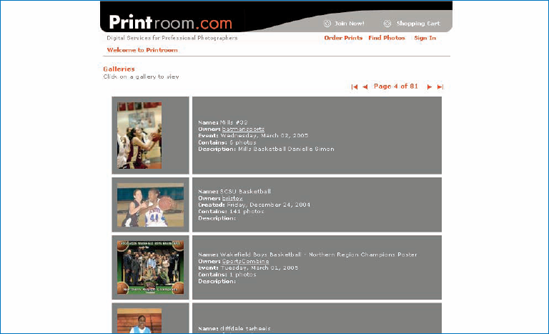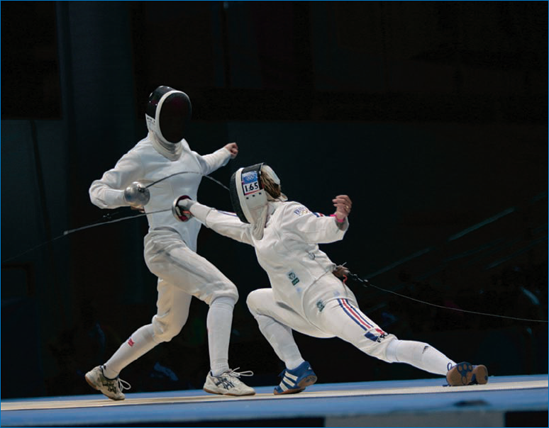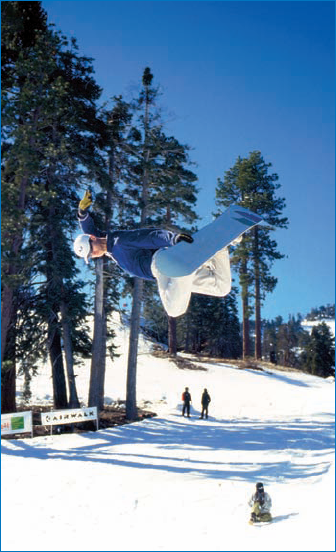
© David Esquire
Digital photography, combined with the proliferation of the very affordable personal computer market, makes for a tremendous growth in interest for selling photography and even going pro. While many pro photographers are grappling with the transition of expensive equipment and new techniques required by a changeover to digital photography workflow, some computer-savvy opportunists are starting their photography careers from scratch and making impressive progress quickly. The basic point here is that there are many levels of digital sports photography, and you can begin to distribute and even sell your photos now. Maybe you'll continue to improve your technique and upgrade your equipment — or maybe not. But in any case, you can find an audience, and maybe a market, for your digital sports photos.
Professional photography has changed dramatically over the last few years with the advent of a digital world, not the least of which has been the Internet and its amazing capabilities for presenting, transporting, and distributing photography. Some of the traditional areas of professional photography have become less viable as a business, while others are booming For example, it's much tougher today to make money shooting commercial products for catalogs or even Web sites. Many businesses are satisfied with digital snapshots of their buildings, executives, and even the goods they produce to be used on their Web sites and elsewhere — even though the composition and photographic quality of those images are clearly lacking.
Likewise, in sports, many people today are able to take digital photos of their family members as they compete or participate in various events using cameras that produce good photos. However, for any action sports, most consumers realize quickly that sports photography requires more technique and equipment than they have. Team photos, like the one in Figure 12-1, are in constant demand on many levels, from pro teams to school and community teams.
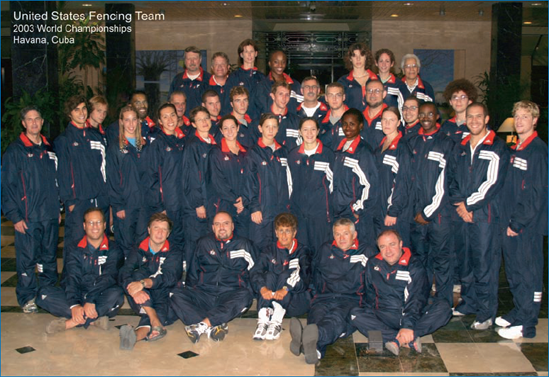
Figure 12-1. Not every team photo can be planned ahead and shot with optimal lighting, backdrops, and team participation. This photo of the U.S. national fencing team was shot in a hotel lobby in Havana, Cuba, and required some creativity for lighting both at the shoot and later in Photoshop.
Full-time professionals have practiced their skills with photography to the point that they know how to take shots that people want to see in the sport they're shooting But that doesn't mean you can't also identify shots that people will want to display or purchase. There are important realms of digital sports photography where non-professionals can find space to take distributable, and marketable, photos. For example, regional teams in your area might need team-and-player photographs Stock photography, meaning the creation of images that can be used generically for advertising and marketing purposes by agencies and companies, is another viable and very specific type of shooting. Yet another type of photography is sports journalism, meaning photographers who shoot for magazines, newspapers, and news agencies. Finally, event photographers such as those shooting races and competitions can do quite well, but it takes some work getting established with race officials and organizations and the old "Catch-22" applies: It's always easier to become involved if you've already been involved.
All these areas are ways in which people today are making a living — some full-time and even more part-time — with their digital cameras. Is it for you? That is what this chapter helps you consider and understand.
One of the most traditional ways to make money in sports photography is to take photos of teams and players in posed shots that are sold ahead of time — much like school photos are done Photographers offer a variety of packages to the team members, who take home and review the options for the shoot ahead of time and show up to have their photo taken with a check or credit card in hand.
These photographers have put into place a system that allows them to fulfill their shoots, to market and sell them, and to build a repeat business. Most often, they are supported by a specialized lab focused on this type of photography that supplies them with all the marketing and sales materials they need to optimize their sales. And there's a trend today for big companies with literally hundreds of photographers around the country to sell their services to teams of all types.
Although these large photography firms have locked up team photos in some realms, other sports and levels of teams need team photos too. Many photographers set up team and player shoots with some of the sports that aren't quite as mainstream — such as lacrosse, swimming, fencing, martial arts, and so on — and that aren't really of financial interest to the big photo conglomerates. These can be very lucrative if you have a way to pursue the business systematically, and you can offer a reasonable selection of products and services.
If you set up your business properly, you can pitch local sports clubs and teams and begin making money. What do you need? Here are some suggestions:
Write a business plan that covers all the aspects of your business, what you intend to do, how you will do it, how much money you'll make over a given time period and how you'll manage it, how you'll market and sell, and the equipment and resources you'll need. Additionally, you should have an idea of how you'll become part of your target community, whether that's a region, a specific sport, or organization.
Basic marketing materials describing your services, pricing, and information about yourself.
A Web site with information about you and your services, contact numbers and e-mail, and galleries of samples — images you are selling and/or that you've taken.
Equipment suited for the job. This doesn't have to be the highest-end studio camera; in fact, it can be a good-quality consumer model with a relatively simple set of lights and a backdrop. A reasonably powerful and relatively new home computer is likely to be sufficient for getting going. If you're using lights separate from your camera that need to flash in-synch with your camera, you need to have an SLR-type camera that supports external lights (most do). A point-and-shoot definitely is inadequate for this job.
A way to fulfill your images. In other words, you need a relationship with a lab (local or online); if you're doing more than just a few photos, chances are good that you probably won't want to do this kind of printing yourself.
A way to keep yourself scheduled and managed administratively, including your financial infrastructure for processing sales, forecasting revenue, and managing your taxes.
A name for your business.
It's going to be very hard to sell yourself if you don't have at least a minimal portfolio of your work so you can convince a club or team manager that you're the right person for the job So, before you begin the job of selling yourself, you want to actually take some photos to build samples of your work Portraits of individual athletes, as in Figures 12-2 and 12-3, are often easier to organize than teams without experience and help to build your portfolio.

Figure 12-2. A good portfolio shot may be taken with a model, but will always be more believable if the model also participates in the sport he or she is portraying in the image.
You can do it in basically two ways If you already have a relationship with a team — such as one you or a family member are part of — then you have an "in" and you can let them know what you're doing. They may let you shoot the team on spec where you take the photos and either give out free photos in kind, or offer them at a greatly reduced price (which gives them incentive to let you do it in the first place!) as well as a percentage of your gross revenues from the shoot. This last part is essential in winning business — nearly every photography arrangement with a sports team or league involves a percentage (typically somewhere between 15 and 30 percent) of the gross being returned to the organization.
Another way is similar, but meant for a club or team that you don't know; it also creates the foundation for how you ultimately can sell your services to other organizations. You present yourself professionally but admit freely that you're just starting your business and need to build samples. Then you offer them a deal that they (hopefully) can't refuse: You'll take photos for no charge, offer prints and other products to their members at a cut rate (basically your cost), and give them a team print for the club or office for free. And when you begin to work with them beyond your initial discounted "deal," let them know ahead of time that you'll be offering them a percentage of your gross revenue.
Either of these methods works to get you going. If you haven't got much experience shooting these types of images, you're bound to make some mistakes, but as long as you plan ahead and the mistakes are not too catastrophic, these are good ways of establishing your business — and possibly getting a first client out of it. You can expect that in your first attempts at this you might have some poses that don't end up looking as good as you expected, you might have some blinking subjects, and you may accidentally have some images that are soft (out of focus). These things happen, but fortunately digital photography allows you to do quick checks on-the-fly of at least some factors.
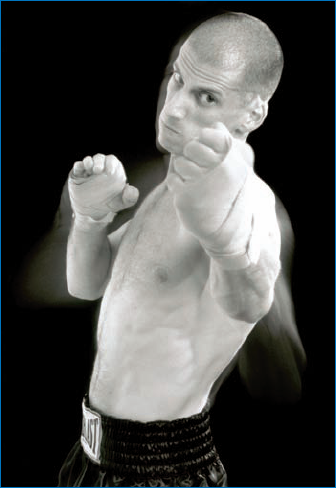
Figure 12-3. Alternative sports — such as kickboxing, martial arts, gymnastics, and others — are growing quickly in the United States and present viable opportunities for independent photographers to sell individual and team photos. © Francis Baker
The foundation of your sales pitch for other clubs, then, after you establish a portfolio, isn't really much different: You offer your services for free (meaning you don't charge the club or team anything to come and do a shoot of their members), and you offer them a free team print as a thank you. The difference is that the services and products you offer the individuals are then at your normal prices.
One of the most important aspects of making this type of business successful is being able to fulfill people's orders in a timely, efficient, and professional manner. Many photographers who are entirely competent to take a good photograph fall down in the follow-through of getting orders processed. This is why I suggest that you connect yourself with a professional fulfillment service adept in working with you at a deeply integrated level to handle your sports photography business needs at the back end — getting photos printed, packaged, and distributed.
As discussed in Chapter 11, various options exist for fulfilling images — including producing prints yourself, using a local lab, or using an online service. Although many of the services focus on professional photographers, and some specialize in school and sports photos, few if any focus exclusively on team and individual sports. Also, some of the services are regionally exclusive or big corporate entities, which means that they have professional photographers with whom they've established contractual agreements; they may not work with you, even in a non-related sport.
School Photo Marketing (www.schoolphotoonline.com) is a smaller, but very good, photography service available for first-time as well as highly experienced photographers (see Figure 12-4). They pride themselves in helping independent photographers compete effectively against the big sports and school photography companies. The New Jersey-based service isn't a lab, but rather it supports school and sports photographers with a wide range of products suitable for selling and packaging your prints. The CEO, Rob Klepner, suggests the following if you're interested in getting into the business of team and player photography:
"The sports [and school] photography market is re-energizing with a whole new level of business due to digital. The independent and new photographer has to have a game plan and be able to sell, know to whom they're selling, be ready to show packages with pricing. And what many photographers don't realize is that half the reason many clients buy is the personality of the photographer, not necessarily the product. They have to knock on doors, put in bids, and earn the business. They need to know their products, their lab, how fast products are going to be turned around, and so on."
School Photo Marketing is one of several companies that works with pro and semi-pro photographers to get their photos produced, packaged, and fulfilled professionally. Here are some of the things companies may offer:
Wallet-sized photos
Framed photos (with customized sports frames such as soccer balls, basketballs, and so on)
Photo plaques
Photo key chains
Tip
You can search for more vendors that cater to your needs in this area by searching for "school photos" in Google.
Stock photography are images created and then sold to a service that markets them to advertising agencies, graphic design firms, and other businesses (primarily) that need generic images of various sorts. Until the Internet became a big deal, these used to be managed by stock agencies that published high-quality thumbnail images in large books. The design firms and ad agencies would pick photos they liked and order them, which would be delivered on film or in digital form for use in ads, brochures, and myriad other commercial uses.
Today, most stock photography is managed online and dominated by a few extremely large stock agencies followed by a plethora of smaller ones — many of whom are happy to take photos from amateur and semi-pro photographers, perhaps such as yourself Corbis and Getty Images are the two large agencies — I shoot fencing for Corbis — and offer hundreds of thousands of images of all types. The same ad agencies and graphic design firms that used to pick from a book can now simply go online, review the available images, purchase them, and download them; the download includes license and usage rights for their various applications Figures 12-5 and 12-6 illustrate the kinds of photos I've supplied to Corbis.
Photographers of all types shoot these images, and the images are as varied as you can imagine: business, arts, sports, entertainment, abstract, nature, people, places, and conceptual — pretty much anything you can imagine. However, what really distinguishes most stock photography is its generic quality, which means it lacks brand names, logos, and other factors that would be limiting from a copyright standpoint. This also means that virtually anyone who buys the photo(s) can use it — which can be risky for some companies if they have the same image in their ad or publication as a competitor's — but you, as the photographer, will want to sell as many of the same image as possible to make ongoing revenue from your image(s). Furthermore, stock photography often features series of images in a concept. For example, for baseball, you might find numerous photos of balls, bats, and gloves in one series; another series might have batters in a variety of images and poses.
Stock photography is a specialized area, and it's not the kind of photography you get paid for up front; instead, you shoot stock images, provide them to the agency, and over time hope they will sell — for which you get a specific payment and/or commission. Unless the stock agency specifies otherwise, images must be completely devoid of brand identity. So if you are going to try your hand at taking stock photos, follow these guidelines:
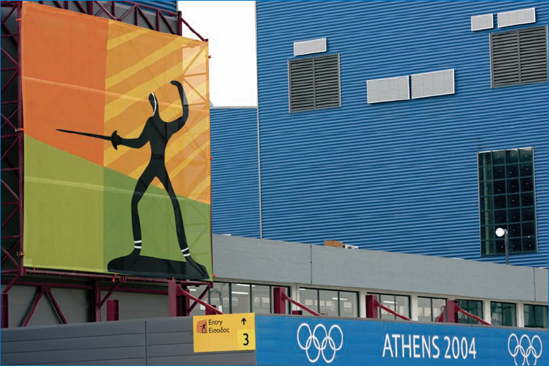
Figure 12-6. An environmental photo of the fencing hall, often useful for news editors needing to "tell a story" about a competition or event
No logos on vehicles, products, clothing, and so on.
No signs or recognizable names anywhere in the photo (for example, a car driving in front of a McDonald's restaurant would be unacceptable).
Logos, branding, names, and so on must not be present on sports equipment; even something like the three stripes on Adidas shoes or an article of clothing would be potentially problematic — even if the name Adidas is not visible.
Stock agencies like series of images, showing many versions of the same image, because buyers want to be able to select just the right image. Greg Choat, a sports editor who acquires various stock images for Corbis, advises photographers to "think in concepts." You should look for ideas that are represented by images. Use the following terms as a start:
Argument
Agreement
Speed
Perfection
Conflict
Determination
The old adage of "a picture is worth a thousand words" applies to stock photography, in spades. Focusing on conceptual image development and thinking of as many angles and ways to portray a subject as possible is essential in this area of photography.
However, one of the biggest problems for photographers — and for stock agencies — is being able to pare down images Often, and especially in the digital age, they receive far too many photos, and they don't like having to select images It's up to you, most often, to present your best work.
Images must adhere to the standards of the stock agency, which they will specify for you. They often include specific information about ownership and usage, and how you identify images such as placing captions, descriptions, and keywords into metadata.
Someone may call for sport-specific stock shots, like the kind shown in Figure 12-5, or shots of a specific team, sport, or athlete. For these, you need the permission of the player or team in writing that you can provide to the stock agency, unless you are shooting in an official capacity with a commercial release, meaning the entity has signed an agreement with you as to how the images will be owned, licensed, and used, who owns them and makes money from them, and so on.
Images must also be sized correctly to the agency specifications and must be of very high quality. You should use images that are perfectly exposed and focused (unless the image is intentionally blurry for artistic or metaphoric reasons, such as to show motion in an athlete); nothing less is acceptable in the stock world.
You may want to focus on one sport and really exhaust what you can shoot for it before going to another; alternative sports also are good ideas for stock agencies because they're likely to have many images of football, baseball, and soccer, but perhaps not so many of table tennis, tae kwon do, canoeing, or handball (as seen in Figure 12-7).
You need to have model releases for any non-public events you shoot that include people. The agency may have its own releases for you to use Just because you're developing images for a stock agency doesn't mean you are one of "its" photographers; this means that you won't necessarily have any special access or credentials just because you're providing them with photos.
Some stock agencies will let you try your hand at this type of photography, so take a look at the following; keep your eyes open for new ones popping up with various business models based primarily on Web innovation:
Corbis (
www.corbis.com)Getty Images (
www.gettyimages.com)The Stock Agency (
www.tssphoto.com)iStockphoto.com (
www.istockphoto.com)Index Stock Imagery (
www.indexstock.com)Fotosearch (
www.fotosearch.com)
Commercial photographers often shoot images on assignment, which means that a company or organization has hired them to take photos of something specific, and a contract and financial agreement have been put into place.
In sports, this can mean any of the following:
Shooting photos of a team or individual for publicity purposes
Taking photos of a sports facility for a team or company to use in marketing, advertising, and so on
Shooting a sporting event for a sports organization such as a federation, association, or even a company sponsoring an event
Shooting on assignment for a stock agency (for example, the agency may need a specific type of sports image, and they know that you can provide it)
Shooting on assignment may occur because you happen to know that a specific event is taking place and you call ahead to the organizers or a sponsor. If they don't have an established or arranged photographer, you may be able to shoot the event; if you lack experience or a good portfolio, you can offer to (and they may want you to anyway) shoot the event on spec. But, you can't count on them purchasing any of your photos.
Larger sporting championships, even such as a regional or state tournament in a sport such as soccer or baseball, often have photographers already established, so you may need to start with smaller events and work your way up. However, under no circumstances should you try to shoot an event and sell photos when there's already a photographer contracted to do so.
If it's for publicity or marketing purposes, you work out a shot list with the organizers or team so that you know specifically what kinds of images they want. They may very well want a mix of poses — both individual and/or team — along with traditional action shots (such as a pitcher on the mound, a quarterback getting ready to throw a pass, and so on). If you've established yourself with one of the fulfillment services described earlier in this chapter, you can produce products that the team can offer to fans, athletes, and families, such as trading cards, prints, products like T-shirts, coffee mugs, and so on. Additionally, you will likely have to offer a small percentage (usually somewhere between 15 and 30 percent) of your profit to the team itself.
Sports photojournalists are what many people envision when they hear the term "sports photographer." The majority of photography taking place on the sidelines of major sports — in other words, the photographers you see shooting them — are doing so for publications, sports news agencies, and sports Web sites, primarily. Most of the photographers shooting with me at the Olympic Games were photojournalists, and they make up the vast majority of big-event sports shooting.
Becoming a sports photojournalist is a tough job to pursue and land. It's a competitive world; after all, who wouldn't want to shoot giant sporting events and get paid for it? At the same time, many newspapers and magazines, suffering from reduced advertising revenues over the last few years, have begun reducing their staffs, and photographers are among the biggest vocations hit. Furthermore, those lucky enough to get the jobs find that, with the supply of photographers far exceeding the demand, the pay scales are surprisingly low.
That said, sports photojournalism is a rewarding career, and many sports photojournalists augment their often-meager pay with their own photography businesses on the side, ranging from shooting local teams and individual athletes to portrait and commercial work.
One nice perk of being a sports photojournalist on staff at a newspaper is that usually your photography equipment is supplied, and it often includes very high-quality lenses and cameras. On the down side, if the organization happens to favor Canon over Nikon, or vice versa, and you don't, then you still may have to shoot with what they provide.
Getting into sports photojournalism means having lots of experience under your belt and being able to show a sports editor a hefty portfolio of work germane to the kind of events he or she would assign. Versatility, the ability to produce top-level photos on a daily basis, the willingness to work long hours and sometimes to travel, and other demands will be placed on you to be able to get the sports shots required of a busy publication, especially in a larger city.
Education is also a factor; especially today when photojournalist positions have become less available with trimmed-down newspaper staffs. Having a degree in journalism or communications can make the difference between getting a job and being beaten-out by someone who perhaps has less experience.
Beyond education, if you're intent on building a career in sports photojournalism, you need to build a portfolio first and foremost. You may want to begin by working for a smaller local newspaper, shooting things like middle school and high school sports, before approaching the media in larger cities.
The kind of photographs that sell to an editor fall into specific categories. Unlike stock photography, seldom are the photos going to be generic:
Shots of winning moments, like home runs, athletes celebrating, coaches jumping out of their seats, cheering fans, and so on
Images of victory and defeat, filled with passion and sometimes controversy
Key athletes, especially ones that the community wants to see highlighted and often those assigned by an editor
Environmental shots, such as showing a filled-to-capacity stadium, especially if they relate to news stories
Shots of dignitaries, celebrities, or local notables attending a game
Injury shots, such as a player being taken off the field on a stretcher
Another type of photojournalism is called freelance photography Instead of working on the staff of a newspaper or other media organization, you essentially work on assignment to go to specific events and get photos that you then sell to an editor. This is how many magazines work to get photographs of key events, especially if they lack the resources to hire photographers and send them to lots of events.
A book titled The Photographers Market has been informing photographers for years about all the various publications that hire freelancers, how much they pay, what they assign, who to contact, how to contact them, and so on. This is a great starting place, because it lists literally thousands of publications, including many that are sports-related, and it gives you a sense of what's out there and what you can do to pursue this area of photography.
Many pro sports photographers turn to professional organizations for support in their trade. The Professional Photographers of America (PPA) and the National Press Photographers Association (NPPA), for example, have a number of sports photographers who rely on them for information, insurance, and other benefits.
Another Web-based organization, SportsShooters.com, has a large number of sports photographers who pay a fee to belong to the site, which features a large amount of information, image exchange, and chat lines, information posts, and the like. However, unlike the NPPA and PPA, SportsShooters.com has been very restrictive in allowing new members and seems to be a rather closed community, even for very accomplished and respected photographers who become interested in joining.
Local chapters of the PPA are good to research and see whether they have any special meetings and/or events for sports photographers. Sometimes, these organizations tend to favor portrait and wedding photographers more than photojournalists or sports photographers; however, if you're doing team and individual shooting, you essentially fall into a portrait photography category anyway so you may very well find benefit in checking into what they offer and the meetings they hold.
If the essence of professional or commercial photography is making money with your photos, then many ways are available in which almost anyone can go pro. You don't have to be shooting from the sidelines of a pro basketball game or assigned to cover the Olympics to sell your images; in fact, a large number of photographers selling their work are doing it part-time. However, doing this well, consistently, and being able to replicate your good work day-to-day is a differentiating factor that separates pros from amateurs. It's not always fun or what you want to do; instead, it's what you know you must do, and do it well, to maintain your reputation, credibility, and build your business.
What you need to determine is what kind of photography you want to do and of what subjects. In sports, you have opportunities to shoot teams and individuals, to work for newspapers and magazines, or to develop stock photography. Each requires specific skills and a dedication to building your business, whatever type you've chosen.


